
Selaginella is the sole genus of vascular plants in the family Selaginellaceae, the spikemosses or lesser clubmosses.

Clintonia is a genus of flowering plants in the lily family Liliaceae. Plants of the genus are distributed across the temperate regions of North America and eastern Asia, in the mesic understory of deciduous or coniferous forests. The genus, first described by Constantine Samuel Rafinesque in 1818, was named for DeWitt Clinton (1769–1828), a naturalist and politician from the U.S. state of New York. For this reason, plants of the genus are commonly known as Clinton's lily. The common name bluebead refer to the distinctive fruit of members of the genus. Since fruit color varies somewhat across species, the common name bead lily is used as well.
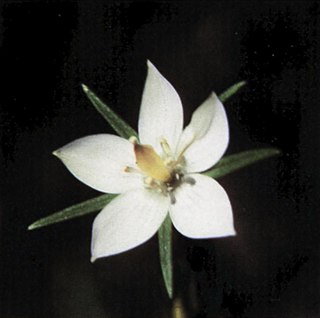
Lomatogonium is a genus of 18 species in the family Gentianaceae, found in cool temperate to subarctic regions of Asia, with two species also in Europe and one species also in North America. By far the highest diversity is in China, with 16 species.

Echinochloa esculenta is a species of grass in the family Poaceae. It is referred to by the common names Japanese barnyard millet or Japanese millet, is a species of Echinochloa that is cultivated on a small scale in India, Japan, China and Korea, both as a food and for animal fodder. It is grown in areas where the land is unsuitable or the climate too cool for paddy rice cultivation. However, the development of rice varieties that can withstand cold has led to a sharp decline in the cultivation of Japanese barnyard millet, in favor of rice. The earliest records of the domesticated form date to 2000 BC from the Jōmon period of Japan.
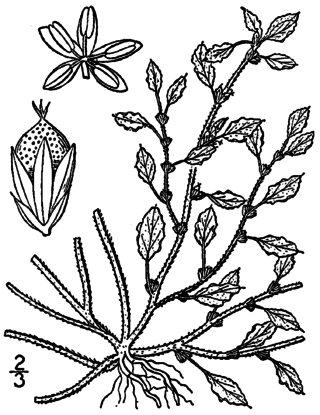
Amaranthus crispus is a species of flowering plant in the family Amaranthaceae. It is referred to by the common name crispleaf amaranth. It is a herbaceous, sparsely pubescent annual plant. It can grow up to 0.5 m (1.5 ft) in height. It flowers in summer to fall. It usually grows in waste places, disturbed habitats, or near water. It is native to Argentina, Chile and Uruguay and has been introduced into Australia, Austria, Bulgaria, Crimea, Czechoslovakia, France, Hungary, Italy, Romania, Sardinia, the United States, and Yugoslavia.

Aloe squarrosa is a species of flowering plant in the Asphodelaceae family. It is from the island of Socotra, Yemen.
Zamia montana is a species of plant in the family Zamiaceae. It is endemic to Antioquia Department, Colombia. Its natural habitat is subtropical or tropical moist montane forests. Zamia montana is extremely rare and is unknown in cultivation. Its habitat is also extremely threatened by logging activities. In fact, it may well be extinct in the wild because the only known population occurs in an area that was recently logged.
Umbilicus chloranthus is a species of flowering plant in the Crassulaceae family. It is referred to by the common names green Venus' navel and ombelico di Venere verdastro. It is native to Albania, the East Aegean Islands, Greece, Turkey, and Yugoslavia.
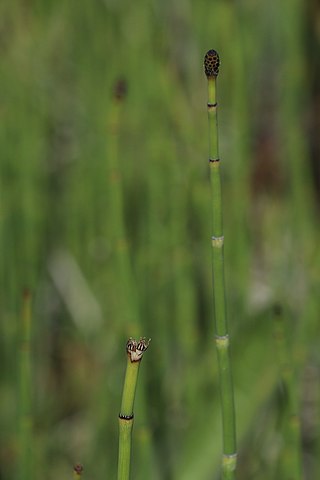
Equisetum laevigatum is a species of horsetail in the family Equisetaceae. It is known by the common names smooth horsetail and smooth scouring rush. This plant is native to much of North America except for northern Canada and southern Mexico. It is usually found in moist areas in sandy and gravelly substrates. It may be annual or perennial. It grows narrow green stems sometimes reaching heights exceeding 1.5 meters. The leaves at the nodes are small, scale-like brownish sheaths and there are occasionally small, spindly branches. The stems are topped with rounded cone-shaped sporangia.

Selaginella selaginoides is a non-flowering plant of the spikemoss genus Selaginella with a wide distribution around the Northern Hemisphere. It resembles a moss in appearance but is a vascular plant belonging to the division Lycopodiophyta. It has a number of common names including lesser clubmoss, club spikemoss, northern spikemoss, low spikemoss and prickly mountain-moss. This plant has one close relative, Selaginella deflexa, native to Hawaii. These two plants form a small clade that is sister to all other Selaginella species.

Selaginella kraussiana is a species of vascular plant in the family Selaginellaceae. It is referred to by the common names Krauss' spikemoss, Krauss's clubmoss, or African clubmoss, and is found naturally in parts of Sub-Saharan Africa and in Macaronesia. It belongs to the very ancient lineage of plants known as the clubmosses.
Euphorbia remyi is a rare species of flowering plant in the family Euphorbiaceae. It is known by the common name Remy's sandmat locally as ʻakoko. It is endemic to the island of Kauaʻi in Hawaii, where it grows in mixed mesic forests, wet forests and bogs from 150 to 900 m.

Botrychium matricariifolium is a species of fern in the Ophioglossaceae family. It is referred to by the common names chamomile grape-fern, daisyleaf grape-fern, and matricary grape-fern. It is native to Europe and parts of eastern North America, including eastern Canada and parts of the United States.

Suaeda vera, also known as shrubby sea-blite, shrubby seablight or in the USA sometimes as alkali seepweed, is a species of flowering plant in the family Amaranthaceae. It is a small shrub, with very variable appearance over its wide range. It is a halophyte, and occurs in arid and semi-arid saltflats, salt marshes and similar habitats.

Najas gracillima, the slender waternymph, is a submerged species of aquatic plant in the Hydrocharitaceae family. found in lakes and streams. It is native to China, Russian Far East, Japan, Korea, Taiwan, Iran, Alberta, Ontario, Newfoundland, Nova Scotia, New Brunswick, the eastern United States. It is also considered introduced and naturalized in France, Spain, Italy and California.
Najas ancistrocarpa is a species of aquatic plant in the Hydrocharitaceae family. It grows in fresh water ponds and is a native to Japan (Honshu) and to parts of China.
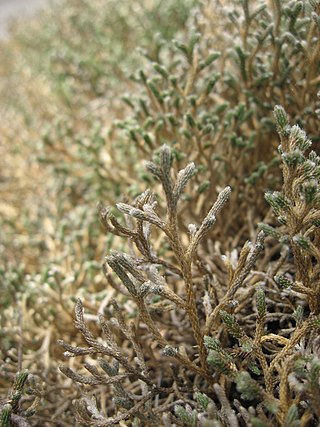
Selaginella tortipila is a species of clubmoss in the family Selaginellaceae. It is referred to by the common names twistedhair spikemoss or kinky-hair spike-moss, and is a member of an early diverging group of plants. It is native to the Southeastern United States where it is found in a small area in the Southern Appalachian Mountains and Piedmont. It is found on granite or sandstone rock outcrop communities, often at high elevation.

Isoetes riparia, the shore quillwort, is a species of plant in the family Isoetaceae. It can be found in rivers, creeks, and tidal mud flats in southern Quebec and southeastern Ontario, south to eastern New York. It has 5 to 35 long, erect bright green to yellow-green leaves, which are 6 to 35 centimeters long. The velum covers one fourth of the sporangium, which can be 7 millimeters long and 4 millimeters wide. The elongated ligule can grow to be 3 millimeters long. The spherical megaspores are 430 to 680 micrometers in diameter with closely set ridges. The kidney-shaped microspores are 24-35 micrometers long, and usually have spine-tipped tubercules. The megaspores can sometimes come to resemble that of either I. echinospora, if the megaspores become eroded and bear projections that could resemble spines, or I. macrospora, if the broken ridges take a certain shape.
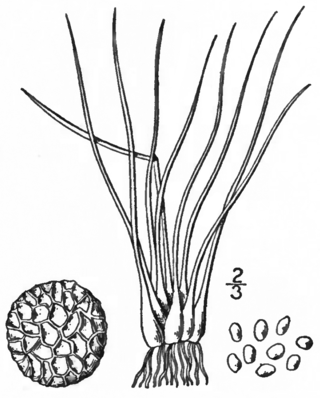
Isoetes tuckermanii, or Tuckerman's quillwort, is a tetraploid species of plant in the family Isoetaceae. It can be found in shallow water in Newfoundland, Nova Scotia, New Brunswick, and south through the New England states to Maryland. It bears 10 to 45 long bright green to yellow green leaves that are 4 to 25 centimeters long, usually erect, but sometimes recurved. The velum covers one fourth or less of the sporangium, which is usually unspotted, 5 millimeters long, and 3 millimeters wide. The white spherical megaspores are 400 to 650 micrometers in diameter, and bear rough-crested ridges that form a hexagonal honeycomb shape. The kidney shaped microspores are 24 to 33 micrometers long, bearing tubercles. It is very similar to I. macrospora, only reliably distinguishable by cytology or through careful megaspore measurement.















